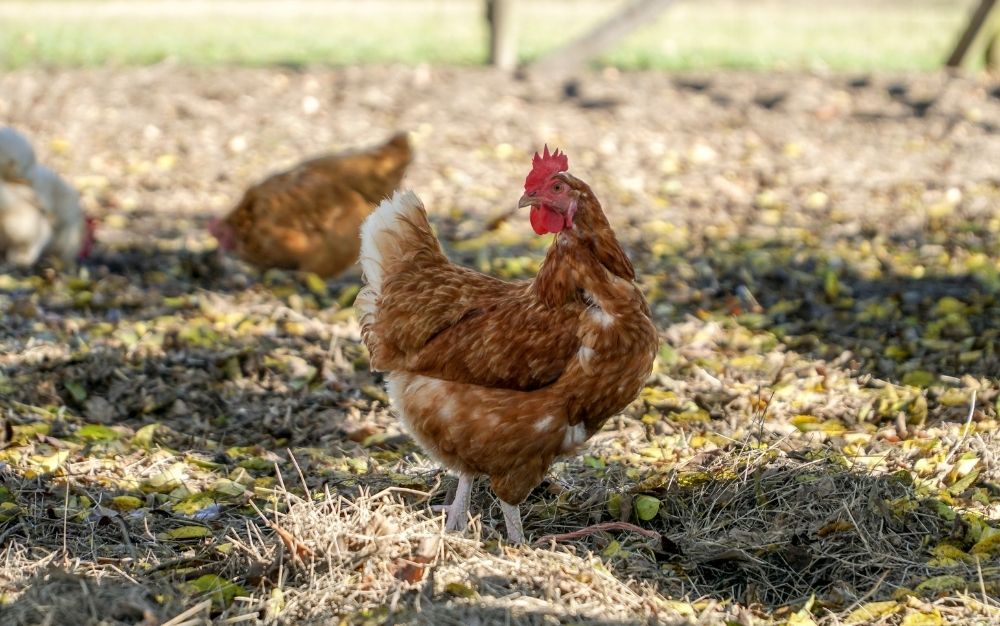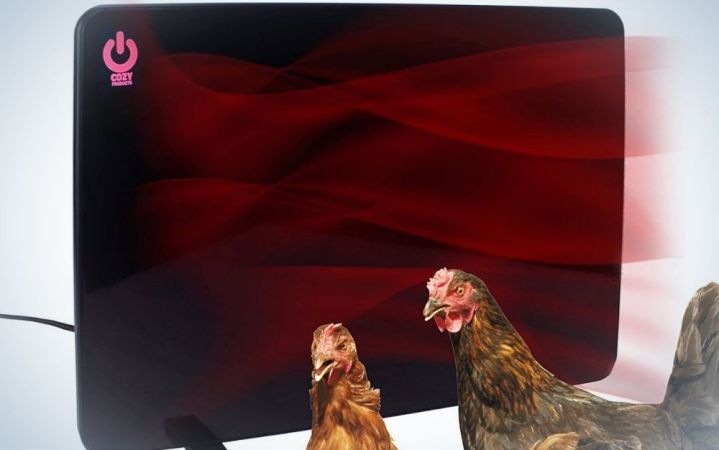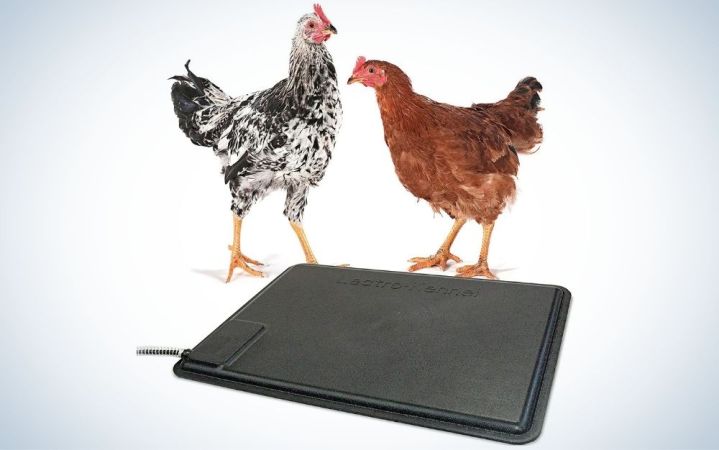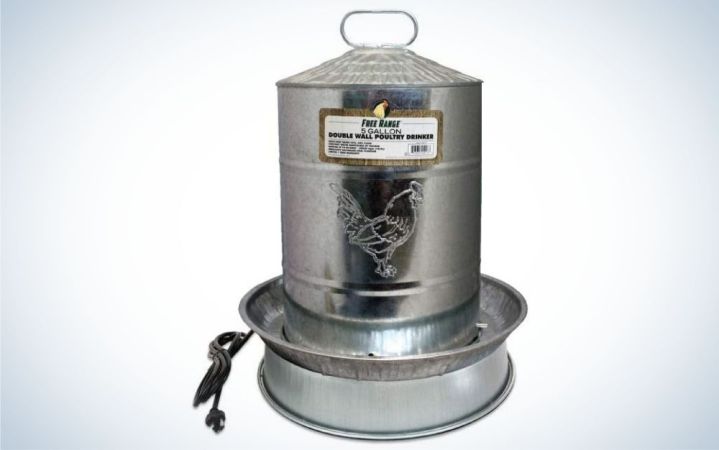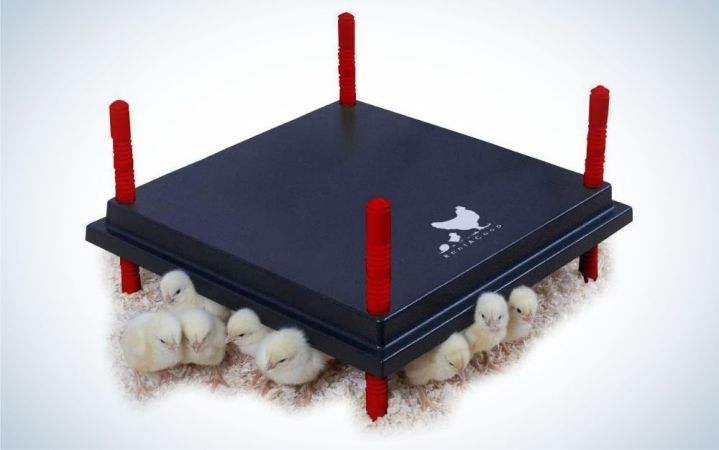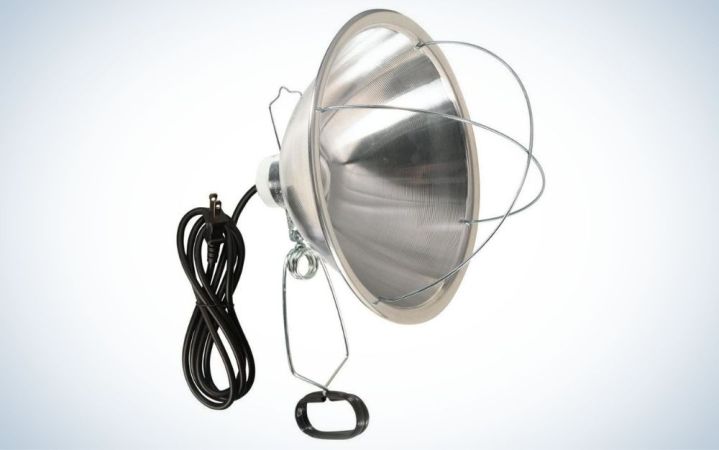We may earn revenue from the products available on this page and participate in affiliate programs. Learn More ›
From frozen eggs to frostbitten combs and feet, cold weather can be dangerous for chickens. While many chickens handle sub-freezing temps just fine so long as they have a draft-free, bone-dry coop to huddle in, some chickens and some circumstances require a coop heater or heat light.
Chicken keepers who live in very cold places and keep breeds that aren’t tolerant to cold or whose flocks include winter chicks or elderly hens should pay particular attention to the temperature in the coop. The best chicken coop heater will raise the ambient temperature enough to keep the flock healthy without risking fire, overheating, or temperature shock.
- Best Panel Heater: Cozy Products Chicken Coop Heater
- Best Contact Heater: Thermo-Chicken Heating Pad
- Best Heater for the Waterer: Harris Farms Waterer heater
- Best Heater for Chicks: Rent a Coop Brooder Heater
- Best Budget Heater: Woods Clamp Light
The Best Chicken Coop Heater
Selecting the best chicken coop heater and teasing out the circumstances that require one isn’t complicated. Chickens—like all birds—descended from theropods. That’s the dinosaur family that includes T. rex and velociraptors. Recognizable chickens emerged about 58,000 years ago and would take up with humans as domesticated livestock about 50,000 years later.
With that robust dino heritage, it’s safe to say that chickens generally have the constitution to handle a little thing like cold weather. And that’s true for cold-hardy breeds and chickens in mild climates. By huddling together and puffing up their feathers to create a super-insulated “coat” in which to tuck their feet and beaks, many chickens weather the cold just fine.
However, chicken keepers who are raising chicks or have elderly hens in the flock who can’t regulate their body temperature will need to provide a heat light or outdoor heat lamp. That’s also true for delicate breeds and keepers in areas where the temps frequently dip well below freezing. For these flocks, a panel heater or heat light that raises the temperature of the coop just slightly can make a big difference in the health and happiness of the birds.
How to Keep Chickens Warm in Winter
When raising chicks or caring for elderly hens, the major concern is the birds’ ability to regulate their body temperatures. This is also an issue for small breeds like Silkies or breeds with exposed skin like Naked Necks.
For chickens in general, the biggest peril is frostbite. When winter hits, chickens depress the blood flow to their feet, wattles, and combs so they can focus their energy on keeping their cores warm. As a result, those tissues receive less oxygen and are at risk of freezing. This is especially true if the chicken gets wet from a leaky coop or even from messily drinking water.
The first signs of frostbite are color changes and swelling in the feet, wattles, and combs. These will also feel cold and hard upon inspection. Frostbite can cause serious symptoms, like blackened tissues, limping, reduced appetite, and listlessness. Chickens with frostbite should be removed from the coop and carefully (and slowly!) warmed. They may require veterinary care.
The best way to avoid frostbite is to provide a draft-free, dry coop. It’s also a good idea to work with the chickens’ instincts to huddle up by swapping out rounded roosts for flat ones. This makes it possible for the chicken to fully cover their feet with their feathers since they can sit flat rather than gripping the roost, which exposes the feet.
If the flock still struggles to keep warm—or if the flock includes vulnerable breeds or life stages—it’s time to set up a coop heater. Traditional heat lights do the job but bring the risk of fire. One alternative is to consider a panel heater designed to lower the risk of fire with safety mechanisms like automatic shut-off.
Best Panel Heater: Cozy Products Chicken Coop Heater
Energy Efficient
Cozy Products’ 200-watt, zero-clearance radiant heat panel safely warms the coop. It’s energy-efficient and includes an internal thermostat and an easy-to-see on/off switch.
Raising Chickens: Heat the Birds, Not the Air
Regardless of the type of heater, it’s important to use heat lamps sparingly. The goal is to increase the temperature inside the coop just slightly to give the flock an edge against the cold. It’s important not to heat the coop too much as the birds may overheat or experience shock if the heat light suddenly loses power. A properly heated coop will still feel chilly to the chicken keeper.
Heat lights and flat panel heaters work by warming the air in the coop—raising the ambient temperature. It’s important to monitor these heaters frequently to stave off the risk of fire and to ensure the coop doesn’t overheat.
Some chicken keepers prefer heaters that don’t heat the air at all. Instead, these heaters work by transferring heat directly to the chicken’s body on contact. This minimizes the fire risk and makes it possible for more vulnerable birds—like those elderly hens or smaller breeds—to stay warmer without overheating the more cold-hardy members of a mixed flock.
Best Contact Heater: Thermo-Chicken Heating Pad
Sturdy Construction
An ultra-low wattage heating pad saves energy by warming on contact rather than warming all the air in the coop. This one can be mounted on the floor or wall and includes a steel-wrapped cord.
Pro Tip: Focus on the Water
Aside from the comfort and health of the flock, another reason chicken keepers choose to heat the coop is to ensure access to fresh flowing water. In areas where temperatures regularly dip below freezing and hold there, chicken waterers can freeze. This leaves the flock without water, which is bad for their overall health and well-being.
Going without water means the chickens will probably go off their feed, and this can trigger a stress response that causes hens to stop laying and molt. Since those feathers insulate the hens, molting in the middle of winter can be hard on the flock.
To avoid this possibility, keepers should regularly check that the chickens’ water hasn’t frozen and may want to use an outdoor heat lamp or heater to keep the temperature inside the coop above freezing—or focus on the waterer itself. Heaters designed to warm the base of the waterer ensure fresh, flowing water even when outside temps dip below freezing.
It’s important to note that frozen eggs will crack, disrupting the bloom coating that prevents bacteria from entering the egg through the porous shell. Frozen eggs are never safe for consumption and should be discarded so that chickens don’t peck at contaminated eggs.
Best Heater for the Waterer: Harris Farms Waterer Heater
Targeted Heat
Harris Farms heated base warms the chicken waterer to keep the water from freezing. It’s thermostatically controlled and works down to 10 degrees Fahrenheit.
Raising Chicks in the Cold
Most chicken keepers leave raising chicks for warmer weather, but a rogue fall or winter clutch or extra cold spring can mean cold-weather chicks. Some keepers even prefer raising chicks in winter since these birds will lay earlier in spring.
While a doting mother hen is the best heat source for winter chicks, it’s a good idea to provide a heat lamp for chicks or outfit the brooder with a heater that transfers heat to the chicks when they huddle under it.
If raising chicks without a hen, the brooder lamp is crucial. Keep the chicks separated from the flock with steady access to the brooder lamp. Monitor the chicks regularly, turning up the lamp (or moving it closer) if the chicks stay huddled in the glow and peep loudly—and turning it down (or moving it farther away) if the chicks appear overheated or stay to the edges of the brooder away from the lamp. The goal is to have happily chirping chicks that are warm enough to eat, drink, and freely explore.
It’s a good idea to carefully inspect the coop or outdoor brooder when raising chicks in winter. Colder temperatures mean hungrier predators, so it’s important to take extra care to ensure their safety.
Best Heater for Chicks: Rent a Coop Brooder Heater
Tiny but Mighty
Rent a Coop is a brooder heater designed just for chicks. Its adjustable heating plate transfers heat directly to the chicks’ bodies—just like a mother hen.
Raising Chickens on a Shoestring
The least expensive way to heat the coop or chicken brooder is a traditional clamp lamp. This device clips in place and heats the air with a bulb. These are the riskiest option when it comes to coop fires, so it’s crucial to follow safety guidelines when heating the coop with a clamp light.
Check the clamp frequently to ensure it’s firmly clamped and won’t fall into the bedding. For extra security against wind or curious chickens, cinch it in place with zip ties. Inspect the cord and extension cord for signs of wear and never combine multiple extension cords to reach an outlet.
Look for a clamp light with built-in safety features—like a bulb guard on the reflector that prevents burns and may protect the bulb if the lamp falls.
Best Budget Heater: Woods Clamp Light
Versatile Design
The Woods clamp light can be used with a regular lamp or red lamp to minimize pecking. The reflector includes a bulb guard for added safety.
FAQ: people also ask
Can a chicken coop heater be dangerous?
There’s always a risk of fire when heating a chicken coop, so it’s important to follow safety guidelines and regularly monitor the coop when the heater is in use.
When do you need to use a chicken coop heater?
It depends on the conditions and the chickens. Cold-hardy breeds may never require a coop heater as they can withstand even freezing temperatures. All chickens need access to fresh water, so the coop or the waterer must be tended to or heated to ensure the water doesn’t freeze. Chicks and elderly chickens can’t regulate their body temperatures like healthy adult chickens, so these chickens may require heat. Very small breeds and breeds with exposed necks or large combs may also benefit from warmer coops.
How to safely heat a chicken coop?
To safely heat a chicken coop, follow all safety guidelines from the heater manufacturer. Always monitor the coop when a heater is in use. It’s important to use the heater to raise the temperature in the coop just slightly to avoid overheating or shock.
The Best Chicken Coop Heater: Consider the Flock
The best chicken coop heater is the one that safely and reliably takes the chill out of the coop and ensures access to fresh, flowing water. Since some breeds and life stages require extra care, keepers raising chickens that aren’t cold-hardy, raising chicks in winter, or whose flock includes elderly hens should take extra care to provide their flock with supplemental heat.
